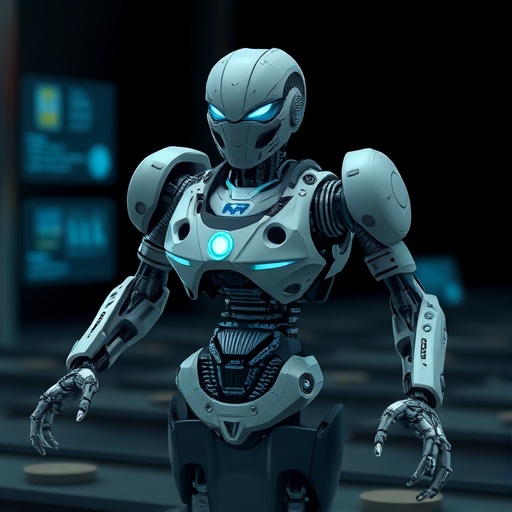In a groundbreaking advance at the intersection of artificial intelligence and mechanical engineering, researchers have unveiled MechRAG, a multimodal large language model purpose-built for the intricate demands of mechanical engineering. This novel AI system integrates visual and textual data streams to revolutionize how machines interpret, analyze, and generate engineering knowledge. The model represents a pivotal leap toward intelligent systems that understand complex engineering designs and concepts with unprecedented nuance and precision, a breakthrough poised to accelerate innovation in design, diagnostics, and decision-making.
MechRAG’s architecture capitalizes on the confluence of natural language processing and computer vision, enabling it to simultaneously process textual schematics, technical documentation, and engineering diagrams. Unlike traditional language models that can only comprehend text, this multimodal approach allows MechRAG to grasp the spatial and geometric subtleties inherent in mechanical engineering illustrations. By bridging visual and linguistic modalities, it mimics the cognitive processes of human engineers who rely on a rich interplay of diagrams and written descriptions to solve multifaceted technical problems.
At its core, MechRAG incorporates a Retrieval-Augmented Generation (RAG) framework—a hybrid method that synergistically combines information retrieval techniques with generative language modeling. This dual strategy enhances the system’s accuracy and contextual understanding by enabling it to dynamically consult extensive engineering databases while formulating responses or design suggestions. Engineers can thus interact with the model as a virtual expert, receiving not only coherent narrative explanations but also data-grounded recommendations informed by a vast repository of technical resources.
The implications of this innovation extend far beyond simple query answering or document summarization. MechRAG’s multimodal capabilities empower it to interpret and reason about detailed engineering blueprints, perform error detection in complex assemblies, and propose optimized mechanical designs. This capability is facilitated by advanced attention mechanisms within the model that enable it to focus selectively on critical visual regions and textual elements, effectively emulating human engineers’ analytical focus during problem-solving.
Moreover, MechRAG offers a transformative tool for mechanical engineering education and training. By providing students and apprentices with a highly interactive, context-aware assistant, it can demystify complex theories and guide users through intricate design processes. The model’s ability to contextualize theoretical concepts within real-world engineering drawings delivers an immersive learning experience that adapts dynamically to individual knowledge levels and learning objectives.
Importantly, the model’s development reflects a careful balance between scale and specificity. While many large language models primarily serve generalist tasks, MechRAG has been architected and fine-tuned with comprehensive datasets curated expressly from mechanical engineering literature, standards, and industry-specific manuals. This domain specialization ensures the model possesses deep and reliable knowledge of fundamental physical principles, material behaviors, and manufacturing methodologies critical to the discipline.
Additionally, the current iteration of MechRAG incorporates interpretability features aimed at enhancing user trust and facilitating expert validation. For example, when generating a design recommendation or failure diagnosis, the model can highlight underpinning sources and visuals that influenced its output. Such transparency is essential in engineering contexts where decisions must meet rigorous safety, performance, and compliance requirements.
The rise of multimodal AI systems such as MechRAG coincides with an era of escalating engineering complexity and rapidly evolving technological frontiers. From aerospace component optimization to sustainable energy system design, engineers face increasing demands for precision and agility. By providing a sophisticated AI collaborator capable of synthesizing and generating rich mechanical knowledge, MechRAG promises to help meet these challenges—reducing design cycles, mitigating errors, and fostering innovation at scale.
Future development pathways for MechRAG envisage integration with real-time sensor data streams, enabling predictive maintenance and anomaly detection in mechanical systems. Coupling the model’s understanding with live operational data could usher in smart engineering ecosystems that self-adapt and self-optimize through continuous AI assistance. This convergence of multimodal reasoning and IoT-enabled feedback loops holds the potential to redefine how complex mechanical systems are engineered, operated, and maintained.
The researchers behind MechRAG have also underscored the ethical and practical considerations tied to deploying powerful AI in high-stakes engineering domains. Ensuring robust verification, bias mitigation, and cybersecurity safeguards forms a critical component of ongoing work. The multidisciplinary team anticipates extensive collaboration across academia, industry, and regulatory bodies to realize a responsible and impactful technology ecosystem that augments rather than supplants expert human judgment.
In terms of scalability, MechRAG’s modular design offers flexibility to incorporate additional modalities such as CAD software interfaces or augmented reality visualization tools, further enriching its functionalities. This extensibility ensures the model can evolve in tandem with emerging engineering collaboration platforms, enhancing multidisciplinary workflows that combine mechanical, electrical, and software engineering disciplines.
Early testing and pilot deployments have demonstrated MechRAG’s efficacy in accelerating prototype review processes and facilitating complex troubleshooting across diverse mechanical systems. Engineers reported a marked reduction in time spent deciphering dense technical materials and enhanced confidence in iterative design refinement. These promising results underscore the model’s potential to become an indispensable component of next-generation engineering toolchains.
In conclusion, MechRAG exemplifies a transformative fusion of AI modalities tailored to the demands of mechanical engineering. By enabling deeper reasoning over visual and textual engineering data, it elevates computational understanding to a level commensurate with human expertise. As this technology matures, it heralds a future where intelligent machines collaborate seamlessly with engineers, driving unprecedented advances in mechanical innovation and education.
Subject of Research:
Article Title:
Article References:
Li, S., Corney, J. MechRAG: a multimodal large language model for mechanical engineering. Commun Eng 4, 187 (2025). https://doi.org/10.1038/s44172-025-00517-z
Image Credits: AI Generated
DOI: https://doi.org/10.1038/s44172-025-00517-z
Keywords:
Tags: AI-driven decision-making in engineeringartificial intelligence advancementsbridging visual and textual data in engineeringcomplex engineering design understandingengineering knowledge generationhybrid retrieval-augmented generation frameworkinnovation in mechanical engineering applicationsintelligent systems for design and diagnosticsMechRAGmultimodal AI in mechanical engineeringnatural language processing and computer visionspatial and geometric analysis in engineering





